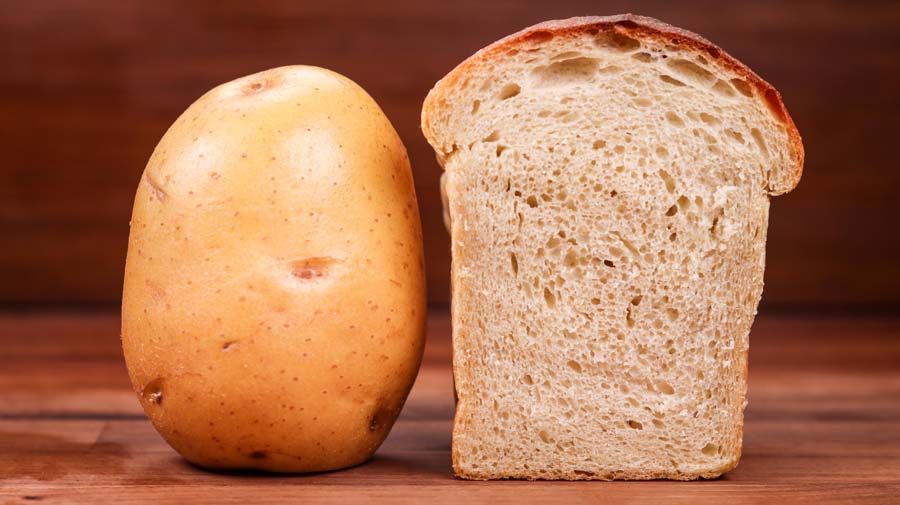Historically potatoes have been used in breadmaking out of necessity. Grain crop failures resulted in smaller yields and less available flour. To fight hunger bakers tried to develop breads including ingredients such as oats, barley, peas, and potatoes. Potatoes turned out to be a great addition to bread and are still used to this day. Not just out of pure necessity but also for other benefits.
How do potatoes affect bread dough?
Potatoes are starchy. Starch is a great thickening agent and various starches are commonly used in cooking/baking for that purpose. Some examples include corn starch, arrowroot, and rice.
Flour also contains starch, but what sets flour apart from the other starches is that it creates gluten when mixed with water. During baking wheat starch absorbs water from the gluten network leaving it hardened and rigid and able to stand up and keep a certain shape.
Like the scalding method, potatoes help bread retain more water. The more water there is the longer the bread takes to stale. But it is not only the fact that there is more water that keeps the bread from drying out. Potato starch is extremely good at holding on to water and slowing down staling.
Gelatinized potato starch gives the crumb and crust a certain plasticity. The texture becomes bouncy, squishy, and moist. Adding boiled potatoes impairs gluten development which weakens the gluten structure making the bread softer. Potatoes promote better crust browning too.
The final benefit is taste and mouthfeel. Potatoes add sweetness and richness to bread.
How to use potatoes in breadmaking?
There are many potato bread/roll recipes out there. Some use more potatoes than others. The amount of potato you use is up to you and your taste and the desired result.
More potato equals higher potential hydration. But it also means that the gluten will become weaker because of all the potato starch. As little as 10% in baker’s percentage can be used to great effect.
Which kind of bread is made also plays a part in the possible amount that could be used. Weaker or gluten free flour breads could become quite heavy if too many potatoes are added.
Potatoes are made up of around 75% water but calculating the final hydration according to this number alone will result in a very dry dough. When it comes to compensating the hydration, I have so far found a general rule of thumb that has worked for me. In baker’s percentage terms for every 1% of potato the hydration of the whole formula should be increased by 0.5%.
Potatoes can be boiled or roasted. Roasting may result in less water content in the potato, but it will also result in a more intense and arguably better flavour. You can leave the skins on for a more unique crumb colour in the final loaf.
The water that the potatoes were boiled in can be used to replace the water in the recipe.
How to calculate a recipe using potatoes.
The original recipe contained 200g flour, 135g water, 4g salt, 2.5g yeast
The hydration of the original recipe was 67%. 135 : 200 = 0.67
I decided to add 50% potatoes. 200 x 0.5 = 100g
As mentioned above I like to increase the overall hydration by 0.5% for every 1% of potato.
50% potatoes = 25% hydration increase. The final recipe hydration was 67% + 25% = 93%.
Since potatoes are 75% water the amount of water contained in 100g of potatoes is 75g. 100 x 0.75 = 75g.
To calculate the amount of total water in the recipe we multiply the flour by 0.93 (hydration). 200 x 0.93 = 186g. Take away the water contained in the potato to find out how much additional water is needed. 186 – 75 = 111g (this would no doubt bother me, and I would round it down to 110g).
The new formula:
200g flour, 100g boiled potatoes, 110g potato water, 4g salt, 2.5g yeast.
There can be a simpler way too.
If you don’t want to deal with calculations, then you could simply replace 1/8 of the flour in a recipe with boiled potatoes. This is a super easy way, but it’s not as precise.
If following the above example, you simply divide the amount of flour by 8, then remove that amount of flour and replace with potatoes. 200 : 8 = 25g.
New formula: 175g flour, 25g potatoes, 135g potato water, 4g salt, 2.5g yeast.
Replacing flour and not adjusting anything else makes sense because some of the flour starch is removed and replaced by potato starch and liquid contained in the potatoes.
If done this way the resulting hydration would be closer to 86%. Bear in mind that the loaves I made ended up gaining pretty much the same volume. That is thanks to the fact that I added potatoes and increase the hydration instead of swapping flour for potato.
If you use this basic method, then your loaf will be quite a lot smaller than it should be.
Potatoes work really well when combined with other ingredients like egg yolk and fat. Same goes for scaled flour.
Watch the video here



